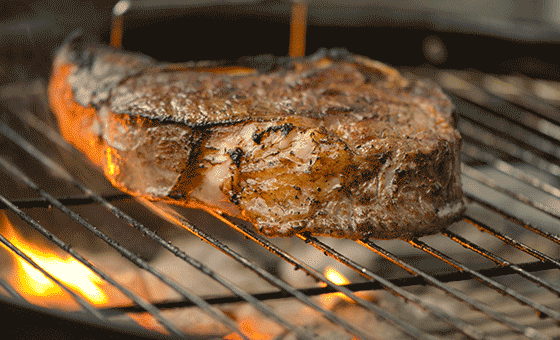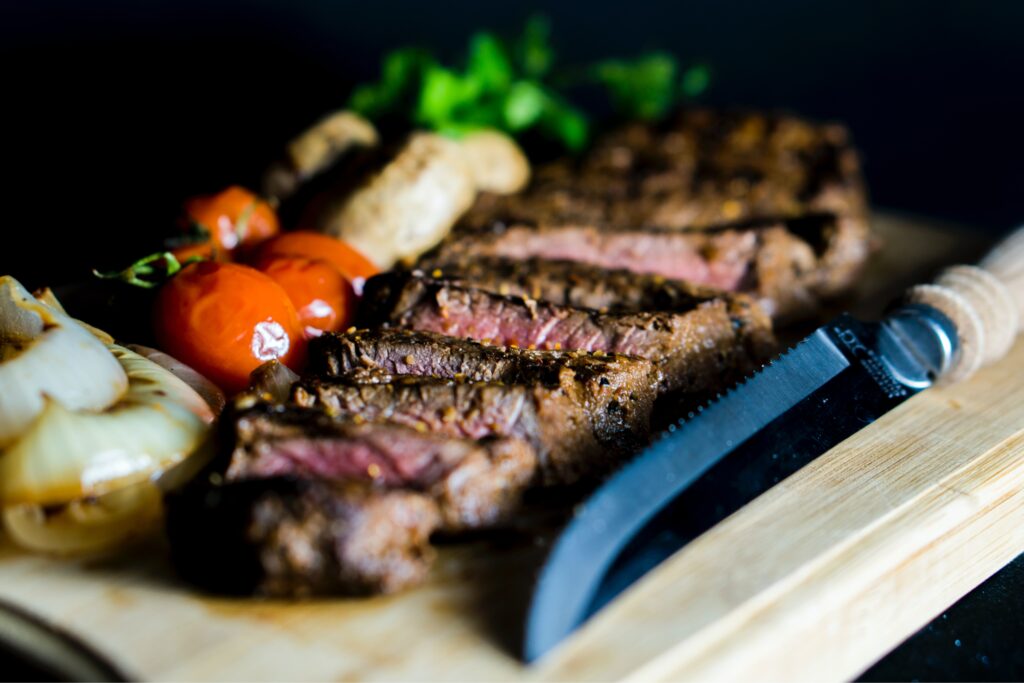
Knowing how to cook the perfect steak is a life skill. It’s up there with learning how to choose a good whiskey. It took me a couple of tries to figure out the best method to grill a steak perfectly, but my, oh my, I’ve got it.
Grilling steak is pretty simple if you know the rules. There are some absolute ‘do nots’ and some absolute ‘musts.’ I’ve broken them down for you and included a recipe.
What You’ll Need
There’s a handful of ingredients I use to make my steak. The hero ingredient here is, of course, the meat. The rest are mainly functional ingredients to get the meat through the process.
- 2 x 12oz steaks around 1 ½ inch thick. I prefer ribeye steaks or sirloin.
- 2 TBS olive oil or canola oil
- ½ tsp paprika
- 1 tsp crushed Himalayan or Kosher salt
- 1 TBS salted butter
- One clove of unpeeled garlic
- Two sprigs of fresh thyme
What You’ll Do
Makes two steaks
Prep time: 5 minutes
Cook time: 6-7 minutes
Rest time: 5 minutes
Total time: 16-17 minutes
Step 1: Bring your steaks to room temperature overnight and pat them dry with a paper towel.
Step 2: Heat a cast-iron or non-stick frying pan on high heat until piping hot.
Step 3: Pour your vegetable oil on a flat plate. Place your steaks onto the plate and turn them around in the oil. You want the meat entirely coated in it.
Step 4: Season one side of the meat with half the paprika and salt.
Step 5: When the pan is searing hot, place the meat onto it, seasoning side down. Season the other side of the steaks.
Step 6: Do not flip the steaks. Leave ’em be. After about 3 minutes, you should be able to lift the steak and turn it. If it’s sticking, leave it for another minute before trying again. This step is crucial in forming a good caramelized crust on the steak.
Step 7: After you flip your steaks, add your butter and thyme. Press the garlic clove flat with the back of a knife and add it to the sizzling butter.
Step 8: Once all sides have cooked, transfer your steaks onto a cutting board and cover them with aluminum foil. Let them rest for 5 minutes before cutting them into strips or serving them whole on the plate. Chuck the garlic out, but keep the butter and thyme in the pan. Reheat it when you’re ready to serve the steaks and pour it over them.
Top Tips For Getting the Perfect Steak Every Time

While this grilled steak recipe is relatively simple to make, there are a couple of tips I want to share with you that are actual game-changers. I mean, there’s steak. And then there’s golden-crusted, buttery on the inside, juicy, and nothing else matters kind of steak. So here they are:
Quality
Choose the best quality you can afford. It’s that simple. If the animal you are about to cook lived a stressful life and went through tons of hormones, antibiotics, and medicine, it will show in the meat’s flavor and texture.
Try getting hold of meat that is free-range if you can. A sign to look out for in good quality meat is a firm texture that appears dry on the surface.
The perfect steak should never be soft or mushy. If you see ripples of fat (called marbling) running through your meat, this will yield a ton of flavor and juiciness.
Room temperature
Room temperature is crucial to achieve the perfect steak. Slapping a chilly steak into the pan will tense it up, resulting in a tough piece of meat. You’ll want to leave your steak overnight or at least a good couple of hours until it’s entirely at room temperature.
Another note is that placing a cold piece of meat onto the pan will lower the pan’s temperature and potentially affect the caramelization and browning. No one wants that.
Dry your meat before oiling
It may seem like a fussy step, but it’s pretty essential. Pat your meat down before oiling it. Any water on the meat will steam and give you a tough piece of meat.
Drizzle oil onto the meat, not into the pan
This essential step gives you the best chance of an even cook, crust, and, ultimately, the perfect steak. It also doesn’t seem to splatter as much when you do it this way.
Heat your pan until it smokes
First, cast iron is the best choice to grill your steak. It just gives a flavor and crust like no other. A stainless steel or non-stick pan will be fine, though; there’s no doubt about that.
Paprika for color
Many people think paprika’s primary function is its earthy, smoky flavor, but it’s not. Paprika gives meat and other dishes a rich-looking appearance and amps the visual. It’s not a critical ingredient, but I think the aesthetic matters.
Get your pan-sear right
I mentioned this in the recipe-try not to turn your steak prematurely. You don’t want to tear it off the pan. That messes with the even caramelization and crust.
Just leave it be and turn it only when it feels like it’s come loose. Pan-searing refers to allowing the meat to cook without moving or messing with it. That puts you one step closer to getting the perfect steak.
Season with salt just before cooking
I season my steak just before adding it to the pan. Doing it too far in advance can lead to dehydration, and seasoning after cooking will leave the salt on the top of the crust but not actually penetrate the meat.
Doneness tips
I like my steak cooked at three minutes aside to medium rare. I feel like you experience the full glory of the flavor this way. For well done, you can take your steak to four or five minutes a side for medium or five to six minutes each.
Wrapping It Up
There are a couple of crucial points to follow to get the best out of your steak when grilling it. If I had to select the number one rule to get the perfect steak, it’s to start with the best quality meat you can get your hands on.
With high-quality meat, you are almost guaranteed good eat. You don’t need to over-season it or be too concerned about whether it’s rare or medium rare. You’ll know the greatness of the steak through its delicious taste and melt-in-your-mouth madness.




